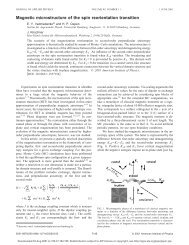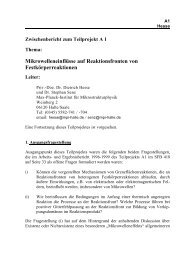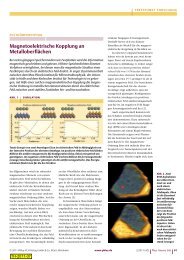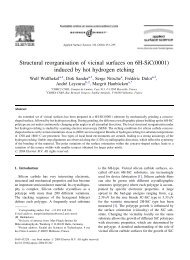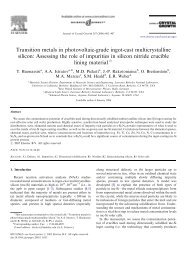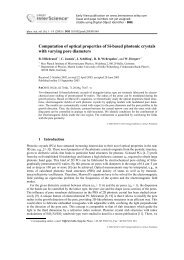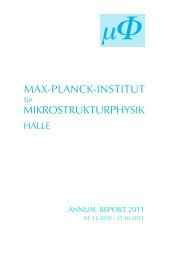Skew Scattering Mechanism by an Ab Initio Approach: extrinsic spin ...
Skew Scattering Mechanism by an Ab Initio Approach: extrinsic spin ...
Skew Scattering Mechanism by an Ab Initio Approach: extrinsic spin ...
Create successful ePaper yourself
Turn your PDF publications into a flip-book with our unique Google optimized e-Paper software.
30 Trends in Magnetism<br />
result, the strongest SHE (Table 1) are present in Au. This mech<strong>an</strong>ism is similar to the strong <strong>spin</strong>flip<br />
scattering at light impurities [13]. As it was discussed already in Ref. [14], the extremely large<br />
α induced <strong>by</strong> the C impurities in the Au host leads to <strong>an</strong> alternative expl<strong>an</strong>ation of the gig<strong>an</strong>tic SHE<br />
measured in gold [17].<br />
Summary<br />
We have performed ab initio calculations of the <strong>extrinsic</strong> <strong>spin</strong> Hall effect caused <strong>by</strong> different<br />
substitutional impurities in the Cu, Ag, <strong>an</strong>d Au hosts. Depending on the chemical nature of the<br />
impurity atom, the SHE c<strong>an</strong> show opposite sign. A strong SHE is provided <strong>by</strong> the p scatterer-<br />
impurity. They have to be either light, such as B, C, <strong>an</strong>d N, in a heavy host like Au, or heavy, such<br />
as Bi, in a light host like Cu. We have shown that the obtained results for the noble metals c<strong>an</strong> be<br />
explained <strong>by</strong> the consideration of the differences of the scattering phase shifts between the impurity<br />
<strong>an</strong>d host atoms.<br />
References<br />
[1] R. Karplus <strong>an</strong>d J.M. Luttinger, Phys. Rev. Vol. 95 (1954), p. 1154.<br />
[2] J. Sinova, D. Culcer, Q. Niu, N.A. Sinitsyn, T. Jungwirth, <strong>an</strong>d A.H. MacDonald, Phys. Rev.<br />
Lett. Vol. 92 (2004), p. 126603.<br />
[3] L. Berger, Phys. Rev. B Vol. 2 (1970), p. 4559.<br />
[4] L. Berger, Phys. Rev. B Vol. 5 (1972), p. 1862.<br />
[5] N.F. Mott <strong>an</strong>d H.S. Massey, The Theory of Atomic Collisions (Clarendon Press, Oxford, 1965).<br />
[6] L.D. L<strong>an</strong>dau <strong>an</strong>d E.M. Lifshitz, Qu<strong>an</strong>tum Mech<strong>an</strong>ics (Pergamon, New York, 1965).<br />
[7] J. Smit, Physica (Amsterdam) Vol. 21 (1955), p. 877.<br />
[8] J. Smit, Physica (Amsterdam) Vol. 24 (1958), p. 39.<br />
[9] M.I. Dyakonov <strong>an</strong>d V.I. Perel, Phys. Lett. A Vol. 35 (1971), p. 459.<br />
[10] S. Takada, Prog. Theor. Phys. Vol. 36 (1966), p. 224.<br />
[11] Y. Onodera <strong>an</strong>d M. Okazaki, J. Phys. Soc. Jpn. Vol. 21 (1966), p. 1273.<br />
[12] M. Gradh<strong>an</strong>d, M. Czerner, D.V. Fedorov, P. Zahn, B.Yu. Yavorsky, L. Szunyogh, <strong>an</strong>d<br />
I. Mertig, Phys. Rev. B Vol. 80 (2009), p. 224413.<br />
[13] M. Gradh<strong>an</strong>d, D.V. Fedorov, P. Zahn, <strong>an</strong>d I. Mertig, Phys. Rev. B Vol. 81 (2010), p.<br />
020403(R).<br />
[14] M. Gradh<strong>an</strong>d, D.V. Fedorov, P. Zahn, <strong>an</strong>d I. Mertig, Phys. Rev. Lett. Vol. 104 (2010), p.<br />
186403.<br />
[15] N.A. Sinitsyn, J. Phys. Condens. Matter Vol. 20 (2008), p. 023201.<br />
[16] I. Mertig, Rep. Prog. Phys. Vol. 62 (1999), p. 237.<br />
[17] T. Seki, Y. Hasegawa, S. Mit<strong>an</strong>i, S. Takahashi, H. Imamura, S. Maekawa, J. Nitta, <strong>an</strong>d K.<br />
Tak<strong>an</strong>ashi, Nature Materials Vol. 7 (2008), p. 125.



